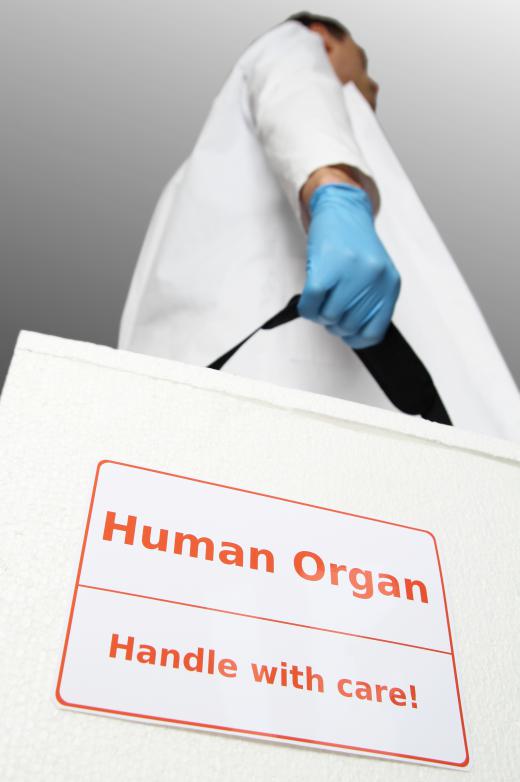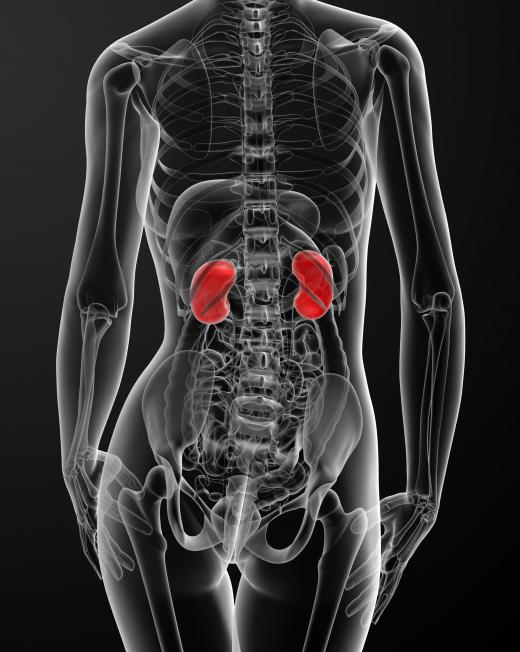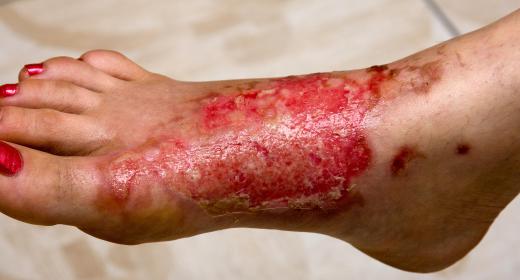What is an Allograft?
 Mary McMahon
Mary McMahon
An allograft is a tissue graft from someone else, in contrast with an autograft, in which the donor and the recipient are the same person. Allografts are routinely used in many branches of medicine to do everything from replacing skin damaged by burns to giving someone with kidney failure a new kidney. Sources for allografts vary, with donor material usually being collected and stored by tissue banks, medical companies which specialize in retrieving, screening, and managing biological materials used in transplantation and grafting procedures.
In the case of an allograft, the donor material comes from a member of the same species, but the donor is not genetically identical to the recipient. As a result, the body of the recipient tends to reject the donor material, because it views the material as foreign. For this reason, recipients have to take medications to suppress their immune systems, and donor material is carefully screened to ensure that it matches the recipient as closely as possible. Blood typing is commonly the first step in screening, with additional screening tests determining the likelihood of allograft rejection.

Some allografts come from cadavers. A variety of donor tissue can be harvested from a dead body, including organs, skin, bone, and eye tissue. People who wish to donate tissue to benefit other people after their deaths can sign up for organ donor programs, and alert their families to their wish for their tissue to be harvested and used. In other cases, it is possible to take an allograft from a living person. Kidneys, for example, can be taken from living donors, most commonly relatives of the patient.

One of the advantages to using an allograft rather than an artificial replacement is that the tissue will eventually integrate into the body of the recipient if it is not rejected. In some cases, however, artificial tissue may be more suitable. For example, in some joint replacement surgeries, success rates with artificial joints and donor tissue are quite comparable. Because new progress is always being made, when patients know that they will be undergoing a medical procedure which involves a graft or artificial implant, they should talk with the surgeon about their options.

If donor tissue comes from an animal of a different species, it is known as a xenograft. One of the most famous types of xenograft involves heart valves from pigs which are used to replace failing valves in people. If a twin donates tissue to his or her twin, it is known as an isograft.
AS FEATURED ON:
AS FEATURED ON:














Discussion Comments
Well, it was not until I requested and received my hospital records that I even knew I had an allograft. The doctor did not mention the possibility before and did not mention it being done afterward. I would have liked to have a choice. And what does it mean that the records show an expiration date?
@hyrax53, I think you meant to say "isograft".
Anyway, I think it is interesting too, I have also read that book. Also, I am assuming that the storyline's concept of a younger sister who is an ideal donor giving is also an isograft, because she had the right genetics; there does not seem to be a term particularly for relatives who donate to one another.
This article's mention of "xenograft" as the term for when a twin donates to another twin makes me think of the book by Jodi Picoult called "My Sister's Keeper". In it, a young couple's daughter is diagnosed with serious, potentially terminal cancer at a very young age. Because they know that they will have to continue having someone to donate to her, the parents have a new child, one of the first "test tube babies", of all of the best genetic material for this sister. The new, younger girl then rebels against her parents at age 13 when asked to donate a kidney to her sister through allograft and refuses to do so.
There was also a movie made, I think two years ago, but they missed a lot of important details and even totally changed the ending, which I think ruined the entire circular nature of the book. While I don't know if something like that would really happen or not, it raised many important questions about both written and moral law, the value of parenting, and how we really view our own bodies and the bodies of others these days. Like many of Picoult's books, I felt it made me ask myself a lot of questions I had never even imagined before.
I read an article a few months ago that the quality of allografts from cadavers has generally been lowering in quality in recent years. Part of this is because, ironically, medical care has improved so much in other areas, as has safety in automobiles and other forms of travel. Fewer people die in accidents, and fewer people die from less threatening diseases and medical problems, leaving the pot of available organs for donors much smaller.
In the article I read, this was an issue when, after she had died of another complication, a father found out his terminally ill daughter would have been given a pair of lungs that had belonged to a heavy smoker. While he admitted her life might still have been extended, the father was outraged that such low quality organs might be considered, except that those are what seem to be left for transplant operations these days.
Post your comments